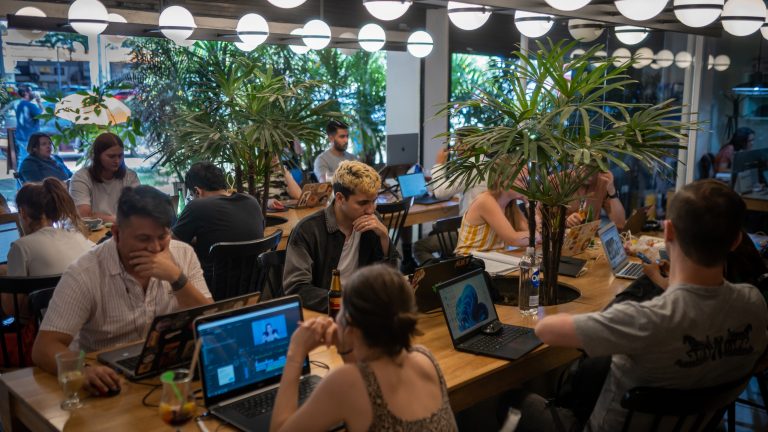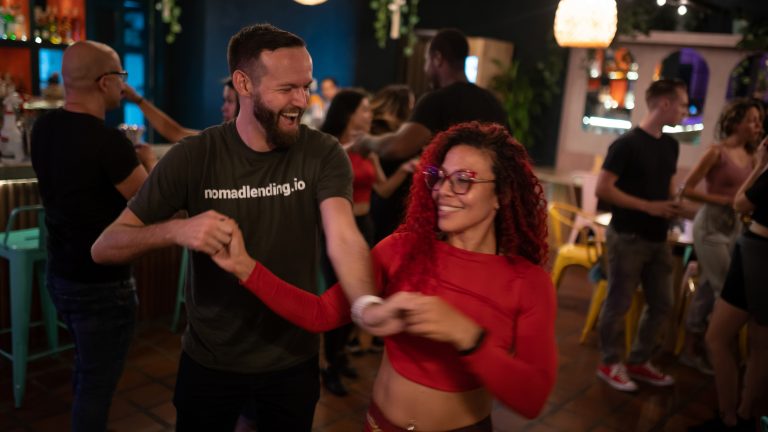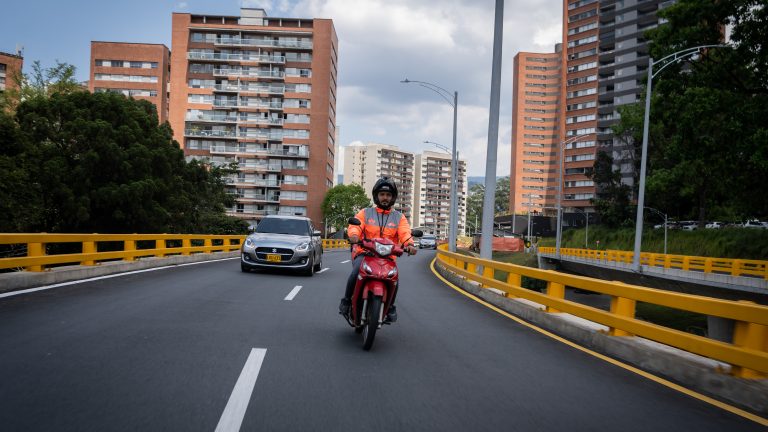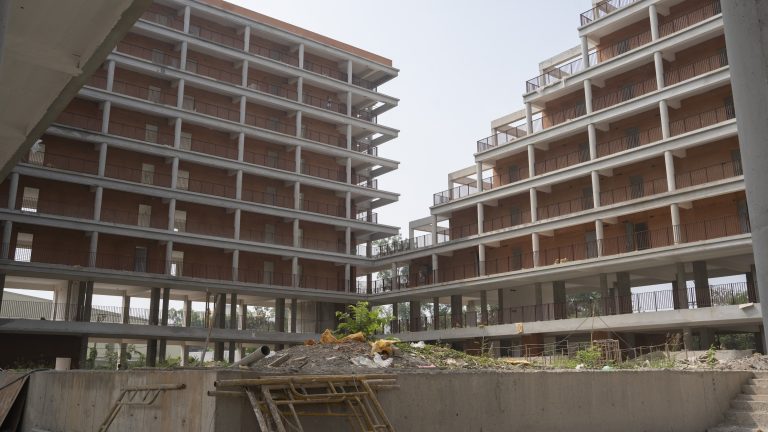The Semilla cafe and coworking space sits in the heart of the upscale Laureles neighborhood in the city of Medellín. It looks as if it were picked up in Silicon Valley and dropped into Colombia by a crane. Coders and digital marketers crowd the tables, drinking pour-over coffee and enjoying loaded avocado toast. Downstairs, in the coffee shop, a stylish woman with a ring light on her laptop chats with a client thousands of kilometers away. Upstairs, in the dedicated office space, an American wearing an Oculus Rift headset attends a meeting in the metaverse.

When digital nomads come to town
What happens to cities when they become digital nomad hotspots?
In this narrated feature, Rest of World looks at how the remote work revolution is changing life in places like Medellín and Bali.
Written by Stephen Witt. Narrated by Victoria Turk.
Original story: https://restofworld.org/2023/digital-nomads-visa-pricing-out-locals/
Most of the workers here are employed in the U.S., but relaxed post-pandemic office norms permit them to work from anywhere. This is the mobile, location-independent lifestyle of the digital nomad. The Semilla is their oasis.
As their name suggests, digital nomads move around a lot. Medellín is one of the latest hot spots to join a global nomad circuit that spans tropical latitudes. Southeast Asia remains the preferred destination for nomads — on popular website Nomad List, four of the top 10 cities are from the region. The list also features less-expensive European cities in Portugal and Romania, as well as Latin American destinations like Mexico City, which share time zones with the U.S. The typical nomad might visit 12 or 13 countries in a year, all the while holding down a corporate job, usually in the tech sector. Of the workers I spoke to at Semilla, most intended to leave Colombia within a month or two.
The nomads I met preferred established, urban destinations with thriving business communities. “Beaches are bad for nomads,” one remote worker told me. “If you can see a surf break, you’re not getting work done.”
Within these cities, nomads cluster in safe and prosperous neighborhoods. Laureles, in Medellín, is a tranquil barrio with a university, clean streets, and middle-class inhabitants. But the income differential between the nomads and the Colombian professional class is immense. The result is runaway price inflation — rents in Laureles have skyrocketed, and restaurants cannot raise their prices fast enough. A one-bedroom in Medellín now rents for the “gringo price” of about $1,300 a month, in a country where the median monthly income is $300.
“Costs are rising because these people are spending a lot of money here, since they think everything is cheap.”
An influx of digital nomads into a neighborhood can distort the local economy. Seeking foreign cash, many cities invite this kind of visitor, but their arrival can skew the cost of living for residents.
Medellín is still in the early stages of nomadification — the last year has seen a boom in arrivals, according to data collected by Nomad List. In some hot spots, nomads are starting to meet greater resistance. In Latin America, Mexico City is the epicenter of the nomad boom. Relaxed Covid-19 policies in 2021 led to a rush of influencers advertising the lifestyle, and the appeal was especially attractive to U.S. citizens, who can stay in Mexico on tourist visas for up to six months. After that, they need a special temporary residence permit — between 2019 and 2020, the country saw an 85% increase in U.S. citizens who asked for one. In 2022, 2,305 temporary residence permits for Mexico City were granted to U.S. citizens, according to the National Migration Institute, up from the 1,417 granted in 2019.

The increase in nomads has become a flashpoint in debates over the city’s housing problems. “[The presence of foreigners] primarily affects the economic livelihood of the regular person here,” said Arturo Mares, a clerk at a furniture store in the upscale Roma Norte neighborhood. “Costs are rising because these people are spending a lot of money here, since they think everything is cheap.” In November, people took to the streets of Mexico City to protest gentrification and rising rents.
- India’s beach paradise Goa is overrun with digital nomads
- Digital nomads now come first for Mexico City’s gig workers
- Dubai is a paradise for “digital nomads”— and hell for low-wage gig workers
Some governments are making moves to defend against similar concerns. In March, just five months after the country launched a digital nomad visa, Portugal curtailed licenses for Airbnbs in an attempt to calm rising housing costs. In Bali, one of the earliest and most enduring digital nomad destinations, local politicians have been viewing nomads with an increasingly skeptical eye.
The digital nomads’ visits are transitory, but they leave neighborhoods permanently transformed. Today, there are streets in Medellín, as in Mexico City or Canggu, that look more like Bushwick — where English is more common than the local language, and where the streets are dotted with brightly painted coworking hubs and prissy restaurants serving international cuisine. The more nomads arrive, the more these locations begin to resemble one another. Building exteriors retain their historic character, but interiors converge to a sterile homogeneity of hotdesking, free charging outlets, affordable coffee, and Wi-Fi with purchase.

The owner of Semilla is Daniel Garcés Botero, a serial Colombian entrepreneur in his 30s. Garcés Botero’s previous businesses included selling carbon-fiber bicycle frames and exporting marmalade — both of which failed. When he opened Semilla in 2019, he wasn’t sure there was enough demand. “It was very hard to get investors,” he said. “Now they’re coming to me.”
One day in January, there were around 70 people in the cafe, and at least 100 more in the coworking space on the second floor. The place was packed with upscale clients, sporting AirPods, statement haircuts, and expensive leather sneakers. On a stair riser against the back wall, a young woman brushed aside her dangling jewelry as she contorted over her laptop. The hiss of the espresso machine could barely be heard over the half-dozen video calls in progress. “I’m going to open another one,” Garcés Botero said.
Digital nomadism can trace its origins to the mid-2000s, but the number of nomads multiplied rapidly during the Covid-19 pandemic, when many workplaces closed their doors. Untethered from their offices, remote workers began moving to countries with relatively light quarantine restrictions. As Covid-19 abated, many found themselves unenthusiastic about returning home, and traveled the world instead, aided by improvements in telecommunications software and the expansion of broadband internet globally.
It is difficult to determine how many workers currently qualify as digital nomads. The most credible number comes from Nomad List, the subscription-based social network. Every digital nomad I spoke with used it. Extrapolating from its user base, Nomad List projects that there are currently about 7,600 remote workers in Medellín, and 265,000 check-ins globally. A survey of Nomad List users showed that about half are from the U.S. and a third from Europe, with the rest from all over the world. In its 2023 report, Brazil and India ranked highest for users outside of the U.S. and Europe.

Nicholas Bloom, a Stanford professor who researches remote work trends, said the true number of nomads was anyone’s guess. His student Alma Andino Frydman, who has been researching the demographics of digital nomads for the past year, observed that nomads could be a little shy about self-reporting. “Especially people who are in arrangements where … how do I say this? Let’s just say their bosses weren’t necessarily aware they were working from a resort in Mexico,” Frydman said. She also observed that the tax status of nomads is often a legal gray area.
Frydman’s research suggests most nomads are white, Western, in their late 20s or early 30s, and employed in software, marketing, or design. They tend to be well-educated and come from affluent backgrounds. Male nomads outnumber female nomads by about 1.5 to one. Frydman’s surveys suggest nomads regard their nationalities, politics, and religions as accidents of birth; they instead define themselves by accumulated life experience. “They’re very, very detached from traditional markers of identity,” Frydman said. Of course, nomads also benefit from a specific kind of passport privilege.

Miranda Wagner and Evan Ryan, a young American couple who’d been traveling and working together since early 2022, arrived in Medellín in January of 2023. Ryan was a tech entrepreneur; Wagner worked in graphic design. Over a breakfast of iced Colombian coffee and waffles, the two described their unusual lifestyle.
“Instead of building a life in Ohio, we were like, let’s just get out of our leases, sell our cars, and basically all of our possessions,” Ryan said. “We’re just gonna travel the world.” Wagner sipped coffee out of a mason jar through a striped straw. “When we started, we thought, ‘Oh well, we’ll try it for a couple months,’” she said. “But now it’s almost been a year, and we haven’t talked about stopping.”
Wagner and Ryan were halfway through the circuit. In 11 months, they’d visited 10 countries, including Croatia, Morocco, Romania, Portugal, and Turkey. Their remaining itinerary included Argentina and Chile, followed by Japan, Singapore, Thailand, and the U.K. Even as they traveled, they saved money, by arbitraging their first-world incomes against the low cost of living in their stopover destinations. “We will probably buy a house eventually,” Wagner said. “But the more you travel, the longer the list of places you want to go.”

Medellín is somewhat unusual on the digital nomad circuit. To locals, it is the “City of Eternal Spring,” with temperatures around 21 degrees Celsius (69.8 degrees Fahrenheit) year-round. It is a visually splendid place, somehow both urban and forested at the same time, with thousands of concrete high-rises dotting the slopes of a leafy Andean valley. But Medellín was once the cocaine capital of the planet, and once the most murderous city in Latin America. Drug trafficking remains a linchpin of its economy; in fact, the U.N. estimates that Colombia now exports more cocaine than ever. The violence has abated in recent years, but the city is not exactly the safest. Of the 25 most popular destinations on Nomad List, it is the only one with a kidnapping advisory from the U.S. State Department.
That hasn’t stopped tech workers from congregating here. Nicholas Austin, a 29-year-old software salesman who rented a desk on the second floor of Semilla, said he wasn’t interested in drugs; he liked salsa dancing. In San Francisco, he’d been offered a job paying $250,000 a year working for Uber. He’d turned it down, taking a $100,000 pay cut to stay with a firm that let him remain nomadic. The pay cut stung, Austin admitted, but his rent was a quarter of what it would have been in the Bay Area, and a six-figure income in Medellín situated him in Colombia’s upper class. “I have to remind myself that I can go out to eat at every meal, and it’s less than I would pay for a sandwich in San Francisco,” he said.

Looking to move beyond the city’s notorious reputation, Medellín’s civic leaders have welcomed the nomads. Claudia Heredia, who heads the Medellín Convention and Visitors Bureau, said she hoped the nomads would stay, and invest. “The influx of foreign money ultimately benefits everyone,” she said.
We sat in a conference room and discussed Medellin’s transformation. When I asked Heredia about the city’s murderous past, she produced a photocopy of a 30-year-old report from a civic planning commission. At the peak of the cocaine era, with cartel violence raging and Pablo Escobar terror-bombing the city, Medellín’s city leaders had decided they would pivot to being a digital goods-and-services hub. By the mid-90s, they completed Colombia’s first and only rapid transit rail system. They pioneered the use of cable cars to connect the residents of the poorer comunas in the mountainside with the rest of the city. EPM, the local municipal utility, proved a model for the developing world, delivering clean, drinkable water, reliable electricity, and some of the continent’s fastest broadband internet.

While Medellín is surely beautiful, it is these patient, unglamorous investments in transport services and broadband that have made it an attractive destination for remote work. The downside is that digital nomads are driving up costs around the city. Restaurants have been especially affected; at the airport in Medellín, I met two American tech workers who were literally attempting to spend as much money on food as they could. “We ordered like, four desserts!” one said. “We couldn’t even break 90 bucks.”
Locals can’t keep pace with such decadence; even the head of the city’s tourism board was being priced out. “I used to go out to eat every Friday,” Heredia said. “Only at current prices, I can’t afford to.”
And yet Heredia supported hosting nomads in the city. In fact, she said she was hoping more would arrive. I observed that her quality of life had been directly affected by their presence. “Yes,” she said, “but it’s better for the economy.”
Some of the other residents shared Heredia’s perspective. Félix Villarreal, a Laureles local, had a positive view of the digital nomads. “They are very friendly, very polite. They’re really interested in our culture, and that leads to a nice interchange,” he said. A 39-year-old IT engineer, he observed that some of his foreign counterparts earned many times what he did. “Of course, I would like to earn that sort of income myself,” he said. “But that’s reality. You can’t change it.”
Last October, Colombia introduced a special visa for digital nomads. Those of them who prove they are remotely employed can work in the country for up to two years. Similar digital nomad visas have recently been introduced by more than 50 countries, seeking to legitimize what had previously been informal “workcations.”
Mauricio Toro, the congressman behind the nomad visa introduced in an entrepreneurship bill, is well-dressed, charismatic, and articulate; he was also the country’s first openly gay legislator. “We realized that this project would benefit more people than we initially imagined,” he said in a video call from Bogotá, stressing that the bill was developed by a committee that included members of all political parties.
Buenos Aires
- Nomad arrivals per month: 6,400 • Airbnb and Vrbo listings: 14,899 • Coworking spaces: 84 • Minimum wage: 80,342 Argentine pesos ($340) per month
Bangkok
- Nomad arrivals per month: 11,000 • Airbnb and Vrbo listings: 13,464 • Coworking spaces: 170 • Minimum wage: 354 baht ($10.50) per day
- Sources:
Nomad List
AirDNA
Coworker.com
Reuters Mexico City
- Nomad arrivals per month: 7,750 • Airbnb and Vrbo listings: 20,022 • Coworking spaces: 249 • Minimum wage: 207 Mexican pesos ($11.50) per day
- Sources:
Nomad List
AirDNA
Coworker.com
Reuters Canggu (Bali)
- Nomad arrivals per month: 8,550 • Airbnb and Vrbo listings: 8,680 • Coworking spaces: 34 • Minimum wage: 2,713,672 rupiah ($180) per month
Medellín
- Nomad arrivals per month: 6,700 • Airbnb and Vrbo listings: 9,755 • Coworking spaces: 50 • Minimum wage: 1,160,000 Colombian pesos ($250) per month
The top six cities for digital nomads
In Medellín, I heard plenty of complaints about rising rents, particularly in the trendy neighborhoods of Laureles and El Poblado, but not much explicit opposition to the nomads themselves. “This is Medellín,” one activist told me. “We don’t protest unless there are bodies in the streets.”
Emily Sánchez, a 44-year-old dance instructor who lives in Laureles, told Rest of World the majority of her students are now foreigners. “It’s very positive for my work, which relies on foreign income,” she said. “But it’s no lie to say that food and rents have become much more expensive.”
She observed that Medellín’s rental bureaucracy actually encourages the spread of digital nomads. “When you rent to a local tenant, there’s a mountain of paperwork,” she said. “So what happens? The property owners switch to Airbnb.”
"The foreigners have changed the structure of the neighborhood. The buildings, the interiors — they are more modern."
Andrés Carmona, a 26-year-old Laureles resident who works in medical supply, suggested that the nomads were adept at avoiding such paperwork. “Somehow, the taxes never apply to them,” he said. But he also appreciated the design improvements inspired by their presence. “The foreigners have changed the structure of the neighborhood. The buildings, the interiors — they are more modern,” he said.
For some, the arrival of a new sort of foreigner, less interested in drug violence and more interested in Wi-Fi, was a welcome change. “I love the digital nomad visa,” said Lorena Lizarazo, a 28-year-old actress who lives in Laureles. “I feel like it opened the doors for so many people to see the good things that the city has to offer.” She observed that many travelers only associated Medellín with narco-trafficking. “Media and television just continue to portray that side of us. That is not our reality.”
There is also the experience of neighboring Venezuela to consider, where the successive regimes of Hugo Chávez and Nicolás Maduro have produced authoritarianism, repression, and near-total economic collapse — 1.8 million immigrants have left Venezuela for Colombia. Toro, who is no longer in office, suggested the arrival of nomads would be a benefit to workers in the local economy, but this is the result of a grotesque disparity of wealth.

One such worker is René Noel, a 29-year-old Venezuelan motorcycle driver who works for Colombian food-delivery giant Rappi. We met for pizza while he was working a double shift. Noel had graduated with a degree in accounting, but after Venezuela’s economic collapse, he’d been reduced to selling empanadas on the Medellín streets. Then, around 2017, the nomads started arriving — particularly those from the U.S., with their high-calorie diets, Doordash addictions, and extravagant tipping culture. Noel’s eyes lit up as he described them. “Los gringos,” he said, “y sus propinas” — “and their tips.” Noel had taken out a loan to buy a motorbike, targeting the upscale neighborhoods where the nomads congregated. Soon he’d paid off the bike, and rented an apartment for himself and his wife. A few days before we met, he’d welcomed his firstborn son.
At lunch, Noel consumed six slices of pepperoni pizza in about three minutes. Then he pulled up a tally of his Rappi earnings on his phone. His receipts showed he worked relentlessly, delivering food for more than 12 hours a day, seven days a week. He’d taken a single day off for the birth of his child, then worked 14 hours the following day. Noel told me he was the top earner in his service region; Rappi had rewarded him with a second motorbike. In this way, Noel managed to earn about $250 a week. One of the programmers at Semilla could make that in a couple of hours.

Mexico City has seen more organized resistance to digital nomads. One flashpoint occurred in 2022, when Becca Sherman, a tech founder from Austin, Texas, tweeted, “Do yourself a favor and remote work in Mexico City — it is truly magical.” She attached a photograph of Pasaje Parián, a recently renovated arcade full of hip stores and restaurants whose waiters greet you in English. Sherman’s perception of the city was poorly received by locals, who complained about nomads transforming beloved neighborhoods into more expensive, English-centered spots. The tweet, which Sherman deleted following the backlash, was later repurposed as an ironic meme focusing on uncomfortable Mexico City situations like hypercrowded subway rides or intense earthquakes.
Anti-gentrification activists later protested the rising costs of living. But in October 2022, Claudia Sheinbaum, Mexico City’s left-wing mayor, signed a deal with Airbnb that intended to promote “creative tourism,” igniting another wave of protests and social media criticism.

José Ignacio Lanzagorta, a lecturer at the Claustro de Sor Juana university in Mexico City, said he sees the impact of digital nomads through the lens of “touristification” rather than gentrification. Lanzagorta said touristified areas are often gentrified to begin with, usually by locals. Condesa and Roma Norte, Mexico City’s nomad hot spots, were both built in the early 20th century and are home to many art deco buildings — they were never exactly cheap. There is, however, a considerable and growing percentage of short-term rentals through Airbnb in these areas, he said.
Arturo Mares, the furniture store clerk in Roma Norte, said his livelihood had been threatened by the arrival of the nomads. “This neighborhood was already expensive and local salaries are just not enough,” he said. Mares said the influx of the nomads hadn’t equated to better wages. “As a waiter or a clerk, bosses and owners start increasing your quotas. You have to sell more and still be paid the same salaries,” he said.
Even as touristification drives up rents, some complain it can also destroy the character of neighborhoods and lead to exploitation. In El Poblado, the formerly artsy district of Medellín, painter Brian Sánchez said that sexual tourism had become a problem in the area. “The nomads bring a lot of good ideas, and they popularized this place via social media, but that brought a different sort of tourist,” said Sánchez, who was priced out of his studio after his rent more than doubled to $1,500 a month.
Jacquie Wortley, a nomad currently in Medellín, said the income disparity between digital nomads and locals could lead to opportunistic relationships. “Because of that income power play, maybe they’ve never had that type of power over women in their lives before. And they can take advantage of it.”

Bali is perhaps nearing an end stage of touristification. The hot spot on the island is Canggu, a coastal village known not only for its restaurants and cafes but also clubs, bars, gyms, and dozens of coworking spaces. Bali sees millions of tourists a year, and has long struggled with their distortional impact. Locals say the worst of the tourists tend to be rowdy Australians and disrespectful Russians, but Bali was also the site of a high-profile scandal involving an American nomad in 2021.
Kristen Gray, a graphic designer, had moved to Bali with her partner in 2020 while continuing to earn income remotely from the U.S. She subsequently wrote an e-book encouraging others to do the same. “This island has been amazing because of our elevated lifestyle at a much lower cost of living. I was paying $1300 for my LA studio. Now I have a treehouse for $400,” Gray tweeted in a now-deleted thread. Gray also touted Bali as an LGBTQIA-friendly destination, despite polls that showed only 9% of Indonesians found homosexuality acceptable.
The tweets sparked an uproar, with a local newspaper claiming Gray’s e-book encouraged remote workers to skirt visa regulations and avoid paying taxes. (Gray denies this.) Local queer activists also accused Gray of being blinded by Western privilege to the considerable difficulties they faced. (On this point, Gray later agreed.) Following a social media firestorm, Gray was deported — officially, at least — for conducting business on a tourist visa.

At a press conference, Gray argued her deportation was the product of homophobia. “I am not guilty. I have not overstayed my visa. I have not made money in Indonesian rupiah. I put out a statement about LGBT rights, and I am being deported because I’m LGBT,” she said.
But a common complaint in discussions about digital nomads in Bali is that they are taking jobs from locals. “People are worried because every day they read news about tourists behaving badly and taking a local job,” said I Ketut Wardana, a board member of the Indonesia Travel Agent Association in Bali.
For the past two years, Indonesia, like Colombia and Mexico City, has considered issuing an explicit “digital nomad” visa. It has not yet arrived.

On my last day in Medellín, I met with Markus Seebauer, a German nomad in his mid-30s who remotely translates technical documents. Seebauer has been on the move for over a dozen years. He graduated to nomadism from backpacking in 2011, when the term “digital nomad” had barely come into existence. Since then, he has lived and worked in around 40 countries. “Even in Siberia, I could get mobile phone reception and reply to emails,” he said.
Seebauer cursed the Wi-Fi in Myanmar, praised the startup scene in Ukraine, and described how he’d nearly been taken hostage in Eritrea. The whole thing seemed to have left him rather weary. “People chase novelty, and you go to a new place, and it’s super exciting, right?” he said. “That wears off over time.”
Seebauer’s aggregate travel experience had created the perfect nowhere man. Adventure was a thing of the past; what kept him going was a kind of chronic restlessness. But the more he traveled, the more estranged he felt from his country of origin. “You don’t want to admit this to yourself, because it’s the culture you grew up in,” Seebauer said of a recent visit home. “But suddenly, you’re having all these weird experiences with the bureaucratic culture of Germany. You see what the foreigners are complaining about. I don’t feel too much connection to Germany any more.”
Of course, in traveling, Seebauer had subtly altered the places he’d visited, too — something he’d noticed more and more as the years wore on. The ribbon of anonymous coworking spaces that now circled the globe had been created to accommodate workers like him, but, in many ways, he resented their presence. “In some ways, it was easier to do this when it was just me,” he said.
Seebauer was thin, with rimless spectacles and a reedy voice. We’d both ordered fresh fruit smoothies, and we drank them in silence for a while. Motorbikes roared past us in the street. I asked him if he would ever settle down. He said the perfect city existed only in his mind. “If I could make one place to live, it would combine the optimism of an Asian megacity, the tech culture of Eastern Europe, and the nightlife of Latin America,” Seebauer said. “And then I’d probably leave.”







